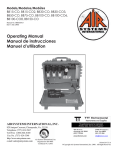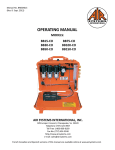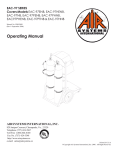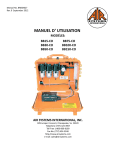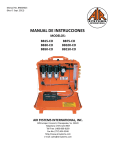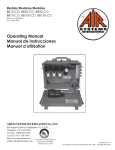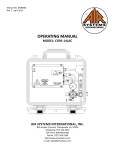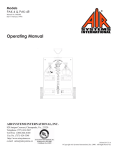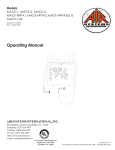Download Amek bb100 series Specifications
Transcript
Models BB30-COAA, BB50-COAA & BB100-COAA Manual No. AABOX011 (Rev 2 June 2005) Operating Manual AIR SYSTEMS INTERNATIONAL, INC. 829 Juniper Crescent, Chesapeake, Va. , 23320 Telephone (757) 424-3967 Toll Free 1-800-866-8100 Fax No. (757) 424-5348 http://www.airsystems.cc e-mail: [email protected] Printed in U.S.A ©Copyright Air Systems International, Inc. 2005. All Rights Reserved. -2- BREATHING AIR QUALITY POSITION STATEMENT The responsibility for the quality of breathing air rests with the user. Compliance with federal, state, or local regulations are the responsibility of the user and this recommendation does not supersede any existing rules, regulations, or laws which may apply. Breathing air filtration products meet or exceed CGA Grade-D specifications for air quality as adopted by Federal OSHA. Compressor air quality standards meet or exceed OSHA 1910.134 requirements. When the components are used in accordance with the manufacturer's instructions and recommendations, the "system" meets or exceeds federal regulations presently in force. It is incumbent upon the user to comply with any changes in the regulations or law which may occur in future situations. The air supply compressor should be located in a safe, clean ambient air environment. This "safe" location should be tested periodically using proper instruments to ensure clean ambient air quality on a consistent basis. Total system Grade-D air quality should be tested monthly. If the compressor is moved, retesting air quality is recommended. Should the location or environment significantly change, the air quality should be retested. The compressor filters and oil level should be checked daily and changed when contaminated or when the maximum number of "run" hours is achieved. This series of air filtration units should be used according to the manufacturer's recommendations. The standard filtration package is not explosion-proof and should be located in a non-explosive environment. (An intrinsically safe model is available, please contact the factory for information.) The carbon monoxide monitor should be calibrated monthly or if the accuracy of the monitor is in question. System air quality should be tested for, but not limited to, the following Grade-D air components: CO - Carbon Monoxide O2 - Oxygen CO2 - Carbon Dioxide H2O - Water (Moisture Content) Hydrocarbons (Oil Mist) Total Particulates The maximum allowable level of these air quality components varies depending on Grade-D or E requirements. Contact sales for a copy of the latest standards. Our Breathing Air compressors and filtration systems meet all of the following federal specifications when used and serviced in accordance with our instructions. Federal OSHA 29 CFR 1910.134 "Compressor Operations for Breathing Air" Army Corps of Engineers EM385-1-1, paragraph 07b-11-4, "Compressed Breathing Air" FILTRATION EFFICIENCY 1st Stage Particulate/Bulk Liquid Separation 2nd Stage Oil Coalescing Particulate 3rd Stage Activated Charcoal and Ultra Auto Drain and Filter change indicator. Removes 95% bulk particulate and liquids @ 5 microns Fine Auto Drain and Filter change indicator. Removes oil and particulate to 99.9998% @ 0.01 microns Manual Drain and Filter change indicator. Removes organic vapors, odors, and tastes. Less than 0.003 pp/wt remaining oil content -3- AUTO-AIR BREATHER-BOXTM OVERVIEW These Grade-D filtration units have been designed for work in hazardous locations where the worker needs additional egress air to escape harmful environments. IDLH atmospheres require that the worker wear a pressure demand airline respirator with a minimum of five minutes of escape air, however, this five minutes of escape air may not be sufficient time to safely egress from the area. The Auto-Air Breather BoxTM is attached to a secondary supply source of air. In the event of primary air loss, the Auto-Air system will automatically switch to reserve air. Audible and visual alarms sound to signal the worker that they are on the backup air system and that they should egress the hazardous work area. Any size reserve air cylinder can be attached to the AutoAir Breather BoxTM, depending on the number of workers and length of time required to safely egress. Plant or mobile compressors provide the primary air supply to the system. Continuous carbon monoxide monitoring is provided to meet federal, state, and local regulations. The Auto-Air Breather BoxTM series will supply Grade-D breathing air, provided the unit is used according to this instruction manual. The carbon monoxide monitor (CO-91AA) continuously receives 50-100cc of filtered air, and monitors for the presence of carbon monoxide. The outgoing pressure regulator(s) is adjustable to conform to the specific respirator in use. To determine the correct pressure, refer to the NIOSH data sheet found with each respirator in use. Note: Always adjust the outgoing pressure with the complete respirator(s) and desired hose length(s) in place. Note: Always operate the Auto-Air Breather BoxTM in the upright position. Failure to comply may result in one or all of the following: • Auto drains will not function properly. This may result in the contamination of the CO monitor and cause water to be passed through respirator hose and into the worker’s mask. • Auto drains may become clogged, clean or replace auto drains (See Maintenance Instructions.) • Filters may accumulate moisture and/or contamination; replace if necessary. MONITOR OVERVIEW A carbon monoxide (CO) monitoring instrument is used in breathing air applications because CO can be ingested into compressor intakes by external exhause emissions, or from the combustion of hydrocarbons (Reference: OSHA standard 1910.134). The CO-91 series monitors have been developed to continuously monitor CO for concentrations in breathing air systems. When connected to an in-line sample stream, these instruments offer continuous, fast response, accurate (+/- 1% full scale) CO concentration levels displayed in parts-per-million (ppm). The CO-91AA will switch to back-up (Auto-Air) service if 115 VAC service has been interrupted, or with a loss of primary air pressure. The instruments activate local and remote audible/visual alarms when CO concentrations are detected in the sample stream, or if the back-up (Auto-Air) service has been activated. -4- SPECIFICATIONS AND PARTS IDENTIFICATION MODEL # SIZE: # OF OUTLETS: WEIGHT: MAXIMUM AIR FLOW (CFM): MAXIMUM INLET PRESSURE: MAXIMUM OUTLET PRESSURE: RELIEF VALVE: BB30-COAA BB50-COAA 24"L x 16"H x 7"D 26.5"Lx21"Hx9"D (61cm x 41cm x 18cm) (37cmx53cmx23cm) 3 4 25 lbs (55kg) 38.8 lbs (17.6kg) 30scfm @ 110psi 50scfm @ 110psi 849 LPM @ 7.5 bar) (1415 LPM @ 7.5 bar) MONITORING: 150psi (10.3 bar) 150psi (10.3 bar) 150psi (10.3 bar) 125psi (8.6 bar) 125psi (8.6 bar) Inline continuous monitoring of Carbon Monixide 125psi (8.6 bar) 125psi (8.6 bar) Inline continuous monitoring of Carbon Monoxide 125psi (8.6 bar) 125psi (8.6 bar) Inline continuous monitoring of Carbon Monoxide BB30-COAA ITEM # 1 2 3 4 5 6 7 8 9 10 11 12 13 14 14A 15 15A 16 17 18 19 20 21 22 23 24 25 26 27 BB100-COAA 26.5"L x 21"H x 9"D 37cmx53cmx23cm) 4 45 lbs (99 kg) 100scfm@ 110psi 2831 LPM @ 7.5 bar DESCRIPTION 12 VDC BULB RED LENS 120 VAC BULB GREEN LENS AUDIBLE ALARM, BACK-UP AIR REMOTE ALARM JACK REMOTE ALARM JACK COVER AUDIBLE ALARM, HIGH CO GREEN LED, NORMAL CLEAR LENS RED LED, HIGH CO PRESSURE GAUGE, 0-160 PSI RELIEF VALVE, 125 PSI QUICK DISCONNECT, HANSEN SERIES QUICK DISCONNECT, SCHRADER SERIES DUST CAP, HANSEN SERIES DUST CAP, SCHRADER SERIES FLOW METER PRESSURE REGULATOR "D" FILTER ELEMENT CO MONITOR FOR AUTO-AIR BREATHER BOX "C" FILTER ELEMENT AUTO-DRAIN ASSEMBLY "A" FILTER ELEMENT PRESSURE SW ITCH BACK-UP AIR INLET FITTING PRIMARY AIR INLET FITTING 3 W AY VALVE FILTER CHANGE INDICATOR BB50-COAA BB50-COAA PART # ELDS001 ELDS005 ELDS003 ELDS006 ELLS004 ELJP004 ELJP005 ELLS004 MONC005 ELDS013 MONC004 GA20160B VR4125BR QDH3SL6M QDSSL6M QDH3DCAP QDSDCAP W L033NS W L014 BB50-D CO-91AA BB50-C W L024 BB50-A PSVLV005 QDH3PL6M QDH5PL6M PSVLV009 W L056 BB30-COAA PART # ELDS001 ELDS005 ELDS003 ELDS006 ELDS004 ELJP004 ELJP005 ELLS004 MONC005 ELDS013 MONC004 GA20160B VR4125BR QDH3SL6M QDSSL6M QDH3DCAP QDSDCAP BB30-FM W L257 BB30-D CO-91AA BB30-C W L024 BB30-A PSVLV005 QDH3PL6M QDH5PL6M PSVLV005 W L0261 -5- MODEL BB100-COAA ITEM # 1 2 3 4 5 6 7 8 9 10 11 12 13 13A 14 14A 15 16 17 18 19 20 21 22 23 24 25 26 27 28 DESCRIPTION RED LENS 12 VDC BULB GREEN LENS 120 VAC BULB AUDIBLE ALARM - BACK-UP AIR REMOTE ALARM JACK REMOTE ALARM JACK COVER AUDIBLE ALARM - HIGH CO CLEAR LENS GREEN LED RED LED PRESSURE GAUGE, 0-160 PSI QUICK DISCONNECT, HANSEN SERIES QUICK DISCONNECT, SCHRADER SERIES DUST CAP, HANSEN SERIES DUST CAP, SCHRADER SERIES PRESSURE SWITCH RELIEF VALVE, 125 PSI FLOWMETER PRESSURE REGULATOR "D" FILTER ELEMENT CARBON MONOXIDE MONITOR "C" FILTER ELEMENT AUTO-DRAIN ASSEMBLY 120 VAC RECESS PLUG "A" FILTER ELEMENT PRIMARY AIR INLET FITTING BACK-UP AIR INLET FITTING FILTER CHANGE INDICATOR 2 WAY VALVE PART # ELDS005 ELDS001 ELDS006 ELDS003 ELLS004 ELJP004 ELJP005 ELLS004 ELDS013 MONC005 MONC004 GA20160B QDH3SL6M QDSSL6M QDH3DCAP QDSDCAP PSVLV005 VR4125BR WL033NS WL015 BB100-D CO-91AA BB100-C WL024 ELJP006 BB100-A QDH5PL8M QDH3PL6M WL056 PSVLV079 MONITOR SPECIFICATIONS SIZE: WEIGHT: CASE: VOLTAGE: SHIELDING: FUSE: OPERATING TEMPERATURE: HUMIDITY RANGE: FLOW REQUIREMENTS: DISPLAY: 2.75"H x 7.1"L x 5.1"W (6.9cm x 17.7cm x 12.9cm) 2.85 lbs. (1.29 kg) Extruded aluminum Anodized black 115 VAC/ 9-15 VDC Internal RFI/EMI filters 115 VAC 1 amp fast acting 4 to 113 degrees F (-20 to 45 degrees C) 10% to 90% RH O UTP UT S IG NALS : TES T CIRCUIT: S ENS O R TYP E: ACCURACY: RES P O NS E: DETECTABLE RANG E: CO -91A A (DC) via 15 pin D-s ubm iniature c onnec tor M anually ac tivated S ealed elec troc hem ic al s ens or, Carbon M onox ide s pec ific + /- 1% full s c ale 90% in 10-15 s ec onds CALIBRATIO N: ALARM S ETTING : 0-200ppm CO M anual z ero and s pan adjus tm ents 10ppm CO (5ppm Canadian) W ARNING : W ARRANTY: *Norm al O peration--G reen Light *High CO --Red Light & A udible A larm *B ac k -up A ir--Red Light & A udible A larm *Low B attery --A m ber Light 2 y ears from original date of purc has e 50-100cc 3 digit LCD -6- REMOTE SIGNAL CABLE CONNECTIONS FOR CO-91AA MONITOR IDENTIFICATION ITEM # 1 2 3 4 5 6 7 8 9 10 11 DESCRIPTION LOW BATTERY INDICATOR CALIBRATION TOOL BATTERY HOLDER REMOTE SIGNAL CONNECTOR RECESS PLUG WITH FUSE HOLDER AUXILIARY DC POWER JACK ON/OFF/TEST SWITCH AIR SAMPLE INLET AIR DISCHARGE PORT (DO NOT BLOCK) AUTO-AIR ALARM ON/OFF SWITCH AUTO-AIR CABLE CONNECTION -7- AUTO-AIR BREATHER BOXTM SETUP AND OPERATION STEP 1) Secure a primary air source of sufficient air flow and discharge pressure. The number and type of respirators being used determines the flow rate and pressure required. STEP 2) Secure a reserve (backup) air supply of sufficient capacity to achieve the desired time for all workers to egress from the hazardous area. The reserve air supply should be able to produce a sufficient flow rate and output pressure based on the flow rate and pressure required by the number and type of respirators being used for a specific duration. Adjust the reserve air supply to the proper discharge pressure for the respirators in use. Note: Reserve air must be at least Grade-D breathing air, and must be set at a minimum of 50psi, but not to exceed 125psi. AIR SAMPLE HOSE STEP 3) Check air line monitor for fresh 9-volt batteries and turn the unit on. Note: The 9-volt battery located in the left compartment supplies REMOTE power to the back-up air alarm system. The 9-volt battery located in SIGNAL CABLE the right compartment supplies a bias voltage to the CO sensor to eliminate warm up times. Connect the remote signal cable, Auto-Air Cable, 115 VAC plug, and air sample hose to the monitor. Place the “ON/OFF/TEST” switch to the “ON” position. Allow 30 seconds for the readout to stabilze. If a reading other than “ZERO” is displayed, calibration of the monitor may be necessary. See calibration procedure pages 13-14. AUTO AIR CABLE STEP 4) Connect the optional remote alarm (if used) into the remote alarm jack.. 115 VAC PLUG -8- STEP 5) Close the flowmeter by turning the control knob fully clockwise. STEP 6) Hold the “ON/OFF/TEST” switch to the “TEST POSITION”. All local and remote audible/visual indicators will activate. If indicators do not activate, check all electrical connections, then call factory repair department. Note: An alarm function test can be performed at any time by lifting the “ON/OFF/TEST” switch to the “TEST” position. STEP 7) Attach the desired respirators and lengths of hose to the quick connect outlet couplings. STEP 8) Connect 120 VAC to the recess plug by way of the supplied extension cord. AC power is required for system to stay in primary air mode. If NO AC power is connected, unit will default into backup air mode. STEP 9) Connect reserve air to the unit at the inlet quick connect plug (1/4” Industrial Interchange). -9- STEP 10) Turn “BACK-UP AIR ALARM” switch to the “ON” position. The red backup light and audible alarm (constant tone) should be on at this time. Note: The “BACK-UP AIR ALARM” switch provides an audible alarm and visual indicator. In the event of a power failure/interruption or a loss of primary air pressure, the alarms will sound and the red back-up indicator will illuminate. STEP 11) Connect primary air to unit at the inlet quick connect plug (1/2” Industrial Interchange). STEP 12) Adjust primary pressure regulator to the proper discharge pressure for the respirators in use by turning the regulator knob clockwise to increase pressure, counterclockwise to decrease pressure.. The presence of sufficient primary air pressure (50psi or greater) will cause the valve to shift out of reserve air position and all audible and visual alarms will deactivate. The green “PRIMARY AIR” indicator will illuminate. STEP 13) Adjust CO monitor air sample flow rate by turning the flowmeter control knob counterclockwise until the float hovers in the green bar area (approximately 50-100cc/min). The unit is now ready for operation. The instrument will analyze the air sample and display the CO concentration in parts-per-million (ppm). The system’s green “NORMAL” operation light will illuminate, and the red “HIGH CO” light will flicker faintly approximately every second when the CO level is below 10ppm (5ppm Canadian). When the CO concentration level exceeds the alarm set point, the green “NORMAL” light will turn off, the red “HIGH CO” light illuminates, the audible alarm will sound, and the remote alarm connections will energize. When CO concentrations drop below the alarm set point, all alarm indicators will deactivate, and return to “NORMAL” operation. SHUTDOWN 1. 2. 3. 4. 5. 6. 7. -10- Make sure all personnel have egressed from the work area. Close reserve air cylinders. Despressurize both the main and reserve air supply lines. Bleed system pressure by pulling the ring out on the relief valve, or relieve pressure through the manual drain located at the base of the filter. Turn monitor “OFF” at the “ON/OFF/TEST” switch. Turn “OFF” the “BACK-UP AIR ALARM” switch. Do not remove 9-volt batteries. These are used to maintain a bias voltage to the sensors; this keeps the sensor ready for immediate future use. Disconnect airline hoses. Install dust caps if applicable. SYSTEM MAINTENANCE CAUTION: Always depressurize the system before performing service. Filter Housing/Bowls: Periodic cleaning of the polycarbonate bowls may become necessary. Simply remove the auto drains. Clean the bowls with a mild soapy solution. Reinstall into the filter housing. Auto Drains: The automatic drains are designed to remove bulk liquid contaminants. The drains (1st and 2nd stages only) will automatically drain the liquids after the level has reached over 1/3 of the bowl capacity. For periodic cleaning, use a mild soapy solution. Filter Change: The filtration system consists of a filter change indicator which will gradually change from green to orange when filter life is spent. Note: Air must be flowing through the filtration unit before filter change indicators will function. Drain Lines: Make sure the auto drain tubes are placed in the holes at the bottom of the box to allow the liquids to drain outside of the box. -11- Calibration: Monitor calibration should be done monthly to ensure accuracy. A calibration date sticker should be affixed for future reference. To obtain an accurate calibration, we recommend the use of Air Systems’ calibration kits. Part Number: BBK-20 Calibration Kit for CO monitor; 20ppm CO gas, zero air, regulator and case 17 liter size. BBK-10 Calibration kit for Canadian CO monitor settings; includes 10ppm CO gas, zero air, regulator and case-17 liter size. BBK-20103 Calibration Kit for CO monitor; 20ppm CO gas, zero air, regulator and case 103liter size. To assure sensor accuracy, calibration of the monitor is required. If you cannot obtain an accurate calibration sensor replacement may be necessary. Consult Repair Service Department before ordering. Part Number: CO-91NS New Replacement Sensor Battery Replacement: Replace 9-volt batteries when the amber “LOW BATTERY” light illuminates. If the monitor is not used for 90 days, check the 9-volt battery condition and replace if necessary. MONITOR BATTERY REPLACEMENT These batteries continuously provide a required bias voltage to the CO sensor and power the monitor in the event of AC power loss. If AC and DC power are removed for a period of 2 hours or more, a 1 hour restabilization period is required on the sensor as eratic readings may occur. Batteries approved for use are: 1. Panasonic Industrial Alkaline Battery - 9 VDC Model No. 6AM - 6PI 9V 2. Duracell Alkaline Battery - 9 VDC Model No. MN1604B2 3. Eveready Battery (Energizer) Alkaline 9VDC - Model No. 6LR61-6AM6-9V -12- SENSOR REPLACEMENT Replacement sensors are shipped with a metal spring installed between the electrodes. Do not remove the clip until the sensor is to be installed into the monitor. STEP 1) STEP 2) Disconnect all external connections. Remove the four screws from the monitor’s Remove CO monitor from the unit. left end plate. Note: Alarm location may vary. STEP 4) Remove sensor from sensor cup and remove leads . Take the new sensor and remove the metal spring. Reattach leads to the proper colored terminals on the new sensor. Install new sensor into sensor cup. STEP 3) Remove end plate to gain access to the sensor cup from outside the housing. STEP 5) Reassemble monitor and install back into system. Connect all external connections. Allow monitor to stabilize and recalibrate. -13- CALIBRATION PROCEDURE Do not use inert gases to zero the monitor. This will cause premature failure of the sensor. CO Zero Adjustment To zero the instrument, follow the steps below. Zero calibration gas should be used to properly “zero” the instrument and assure that a valid calibration is achieved. If zero adjustment cannot be made as indicated, sensor replacement may be necessary. After each monitor adjustment outlined in the following steps, allow time for the changes to stabilize. 1. Place the “on/off/test” switch to the “on” position. 2. Allow 30 seconds for the readout to stabilize. The green indicator light will illuminate. 6. Attach the clear tubing with male plug to the monitor air sample inlet. 7. Open gas regulator fully by turning the knob at least two (2) turns counterclockwise. Note: A controlled orifice in the regulator will allow the gas to flow at approximately 300 cc/min. 3. Hold the “on/off/test” switch in the “test” position. The following will occur: • Audible alarm will sound • Green indicator LED will flash • Amber low battery indicator LED will illuminate • Red lamp on This test ensures the circuitry is operable and the continuity to the sensor is proper. Release the switch. 8. Allow digital readout to stabilize approximately 15 30 seconds. 9. Adjust "zero" pot adjustment screw (clockwise to increase, counterclockwise to decrease) until a "00" reading is obtained. 4. Remove air sample inlet tube. 5. Install regulator on the zero air cylinder reference gas. 10. Turn off the regulator and disconnect the tubing from the zero air regulator. -14- CO SPAN ADJUSTMENT Use only 10 - 20 ppm CO gas for calibration. Using a higher concentration may decrease accuracy at lower scale readings. Note: 10ppm gas must be used to satisfy Canadian calibration requirements. 1. Install regulator to the CO calibration gas cylinder. 5. Adjust the "span" pot adjustment screw (clockwise to increase, counterclockwise to decrease) until the digital display reads the same concentration (ppm) as printed on the calibration gas cylinder. 2. Connect the plug to the monitor. 3. Open gas regulator fully by turning the knob at least two (2) turns counterclockwise. 6. Turn regulator off and repeat “zero” adjustment procedure above. Display should return to a "00" reading. 4. Allow digital display to stabilize approximately 15 - 30 seconds. THE MONITOR IS NOW CALIBRATED AND SHOULD BE RECALIBRATED MONTHLY OR IF ACCURACY IS QUESTIONABLE. CHECK LOCAL REQUIREMENTS AND RECALIBRATE AS REQUIRED. -15- Warranty Disclaimer Air Systems’ manufactured equipment is warranted to the original user against defects in workmanship or materials under normal use for one year after date of purchase. Any part which is determined by Air Systems to be defective in material or workmanship will be, as the exclusive remedy, repaired or replaced at Air Systems’ option. This warranty does not apply to electrical systems or electronic components. Electrical parts are warranted, to the original user, for 90 days from the date of sale. During the warranty period, electrical components will be repaired or replaced at Air Systems’ option. NO OTHER WARRANTY, EXPRESSED OR IMPLIED, AS TO DESCRIPTION, QUALITY, MERCHANTABILITY, FITNESS FOR A PARTICULAR PURPOSE, OR ANY OTHER MATTER IS GIVEN BY AIR SYSTEMS IN CONNECTION HEREWITH. UNDER NO CIRCUMSTANCES SHALL THE SELLER BE LIABLE FOR LOSS OF PROFITS, ANY OTHER DIRECT OR INDIRECT COSTS, EXPENSES, LOSSES OR DAMAGES ARISING OUT OF DEFECTS IN, OR FAILURE OF THE PRODUCT OR ANY PART THEREOF. The purchaser shall be solely responsible for compliance with all applicable Federal, State and Local OSHA and/or MSHA requirements. Although Air Systems International believes that its products, if operated and maintained as shipped from the factory and in accordance with our “operations manual”, conform to OSHA and/or MSHA requirements, there are no implied or expressed warranties of such compliance extending beyond the limited warranty described herein. Product designs and specifications are subject to change without notice. Rev 2 12/98















